Risk Analysis and Management: A Report on the Alibaba Case Study
VerifiedAdded on 2022/08/20
|17
|5819
|15
Report
AI Summary
This report presents a comprehensive analysis of the risk management challenges faced by Alibaba, focusing on the sale of counterfeit goods on its platform. The report begins by outlining the legal frameworks impacting the risk, including US and Australian laws regarding trademarks and counterfeiting. It then identifies the relevant standards applied, such as those enforced by US Customs and Border Protection and the Australian Consumer Law. The analysis addresses the areas of risk, including commercial relationships, and identifies the legal risk as the primary concern. Stakeholders, both internal (e.g., Jack Ma, managers, employees) and external (e.g., customers, suppliers, government), and their objectives are examined. Political, legal, social, economic, and technological changes influencing Alibaba are assessed through a SWOT analysis. The report identifies critical success factors, such as Alibaba's unique business and profit models, and suggests communication strategies with stakeholders. Further research areas are also suggested. The document includes risk assessment, evaluation of likelihood and consequences, and the prioritization of treatment for the risks involved. It also examines opportunities, ways to minimize risks, and a risk action plan, including documentation and communication strategies. The report concludes with an evaluation of the case and the tools used to perform the task, and a reference section.
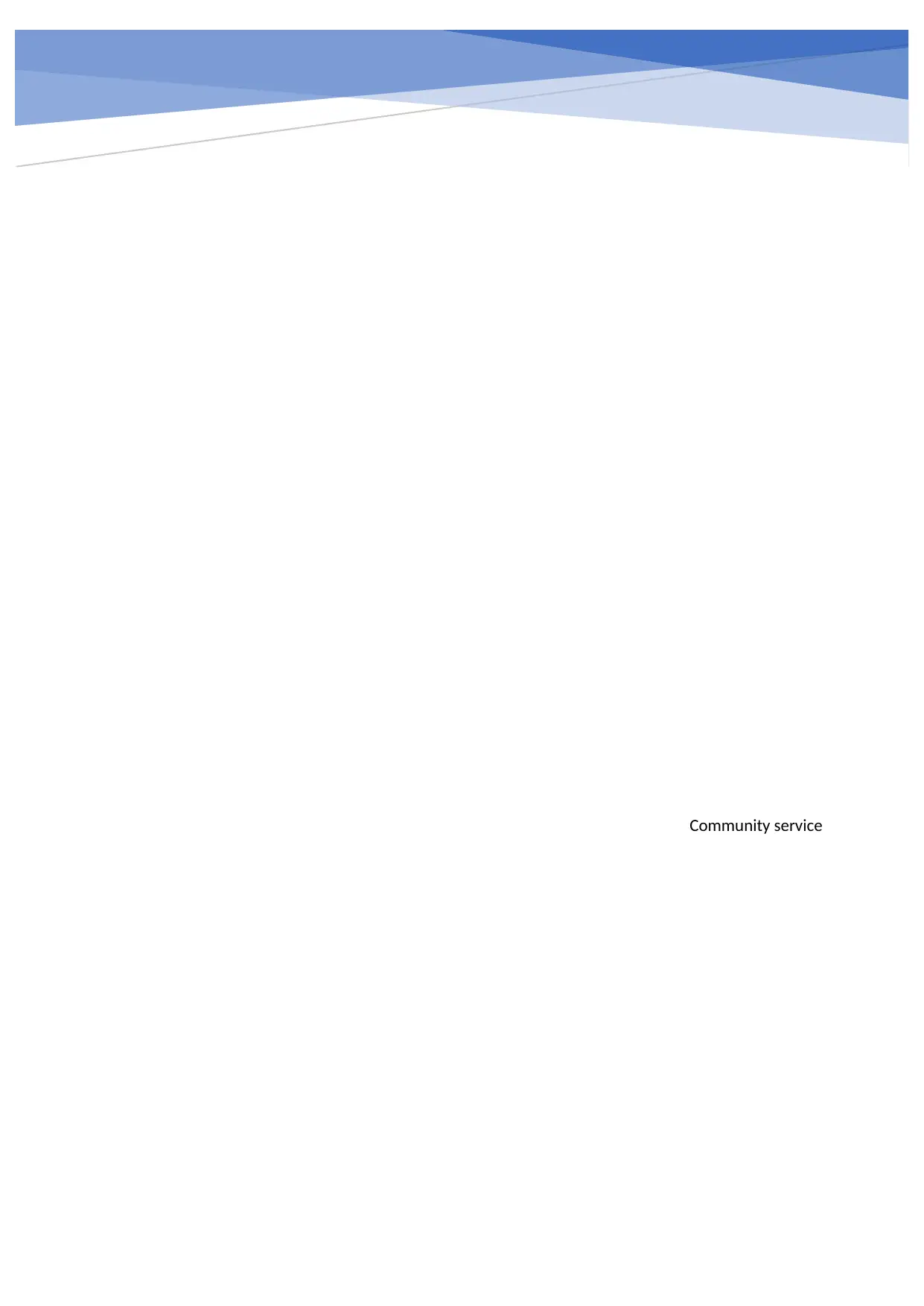
Community service
Paraphrase This Document
Need a fresh take? Get an instant paraphrase of this document with our AI Paraphraser
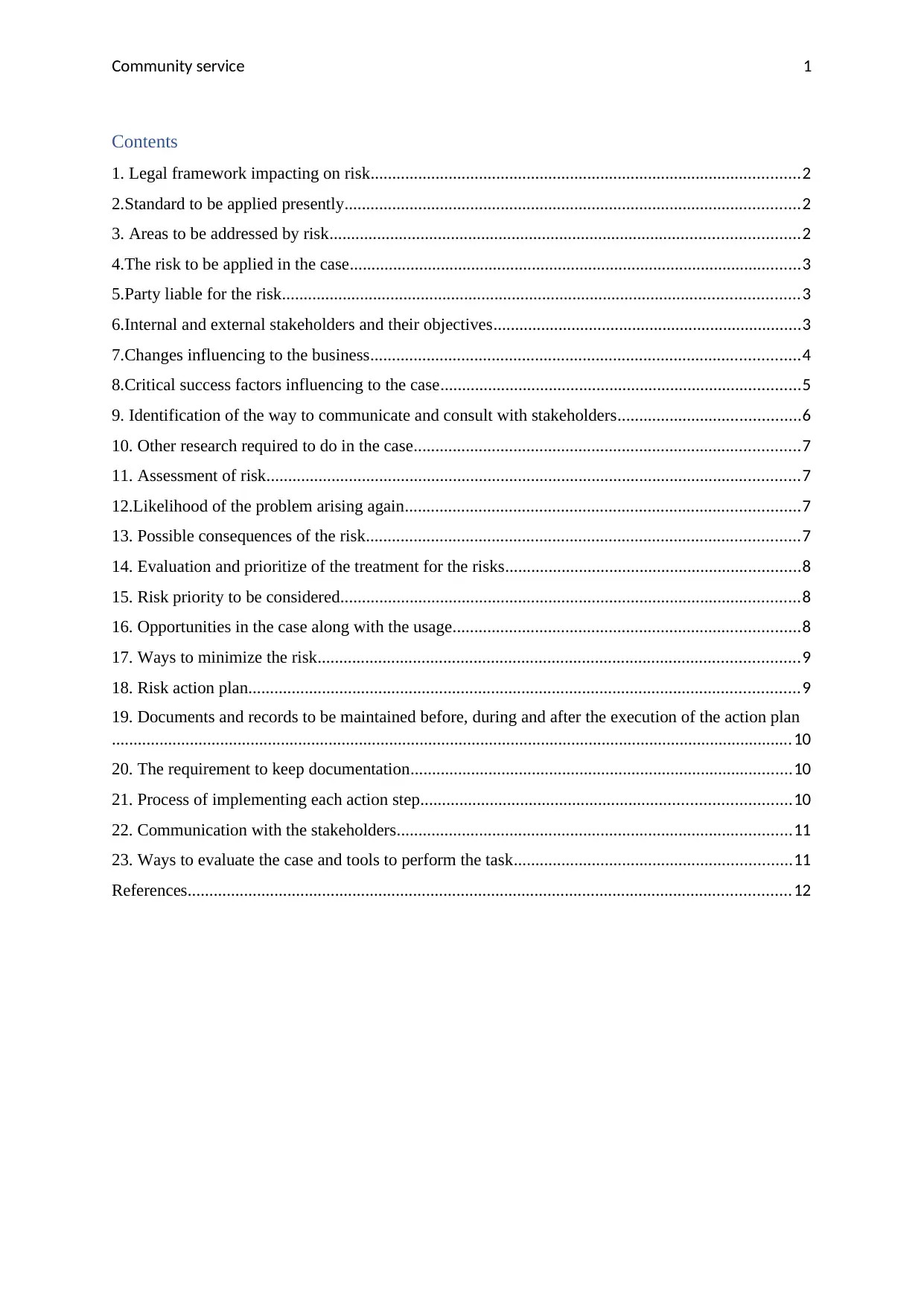
Community service 1
Contents
1. Legal framework impacting on risk...................................................................................................2
2.Standard to be applied presently.........................................................................................................2
3. Areas to be addressed by risk............................................................................................................2
4.The risk to be applied in the case........................................................................................................3
5.Party liable for the risk.......................................................................................................................3
6.Internal and external stakeholders and their objectives.......................................................................3
7.Changes influencing to the business...................................................................................................4
8.Critical success factors influencing to the case...................................................................................5
9. Identification of the way to communicate and consult with stakeholders..........................................6
10. Other research required to do in the case.........................................................................................7
11. Assessment of risk...........................................................................................................................7
12.Likelihood of the problem arising again...........................................................................................7
13. Possible consequences of the risk....................................................................................................7
14. Evaluation and prioritize of the treatment for the risks....................................................................8
15. Risk priority to be considered..........................................................................................................8
16. Opportunities in the case along with the usage................................................................................8
17. Ways to minimize the risk...............................................................................................................9
18. Risk action plan...............................................................................................................................9
19. Documents and records to be maintained before, during and after the execution of the action plan
.............................................................................................................................................................10
20. The requirement to keep documentation........................................................................................10
21. Process of implementing each action step.....................................................................................10
22. Communication with the stakeholders...........................................................................................11
23. Ways to evaluate the case and tools to perform the task................................................................11
References...........................................................................................................................................12
Contents
1. Legal framework impacting on risk...................................................................................................2
2.Standard to be applied presently.........................................................................................................2
3. Areas to be addressed by risk............................................................................................................2
4.The risk to be applied in the case........................................................................................................3
5.Party liable for the risk.......................................................................................................................3
6.Internal and external stakeholders and their objectives.......................................................................3
7.Changes influencing to the business...................................................................................................4
8.Critical success factors influencing to the case...................................................................................5
9. Identification of the way to communicate and consult with stakeholders..........................................6
10. Other research required to do in the case.........................................................................................7
11. Assessment of risk...........................................................................................................................7
12.Likelihood of the problem arising again...........................................................................................7
13. Possible consequences of the risk....................................................................................................7
14. Evaluation and prioritize of the treatment for the risks....................................................................8
15. Risk priority to be considered..........................................................................................................8
16. Opportunities in the case along with the usage................................................................................8
17. Ways to minimize the risk...............................................................................................................9
18. Risk action plan...............................................................................................................................9
19. Documents and records to be maintained before, during and after the execution of the action plan
.............................................................................................................................................................10
20. The requirement to keep documentation........................................................................................10
21. Process of implementing each action step.....................................................................................10
22. Communication with the stakeholders...........................................................................................11
23. Ways to evaluate the case and tools to perform the task................................................................11
References...........................................................................................................................................12
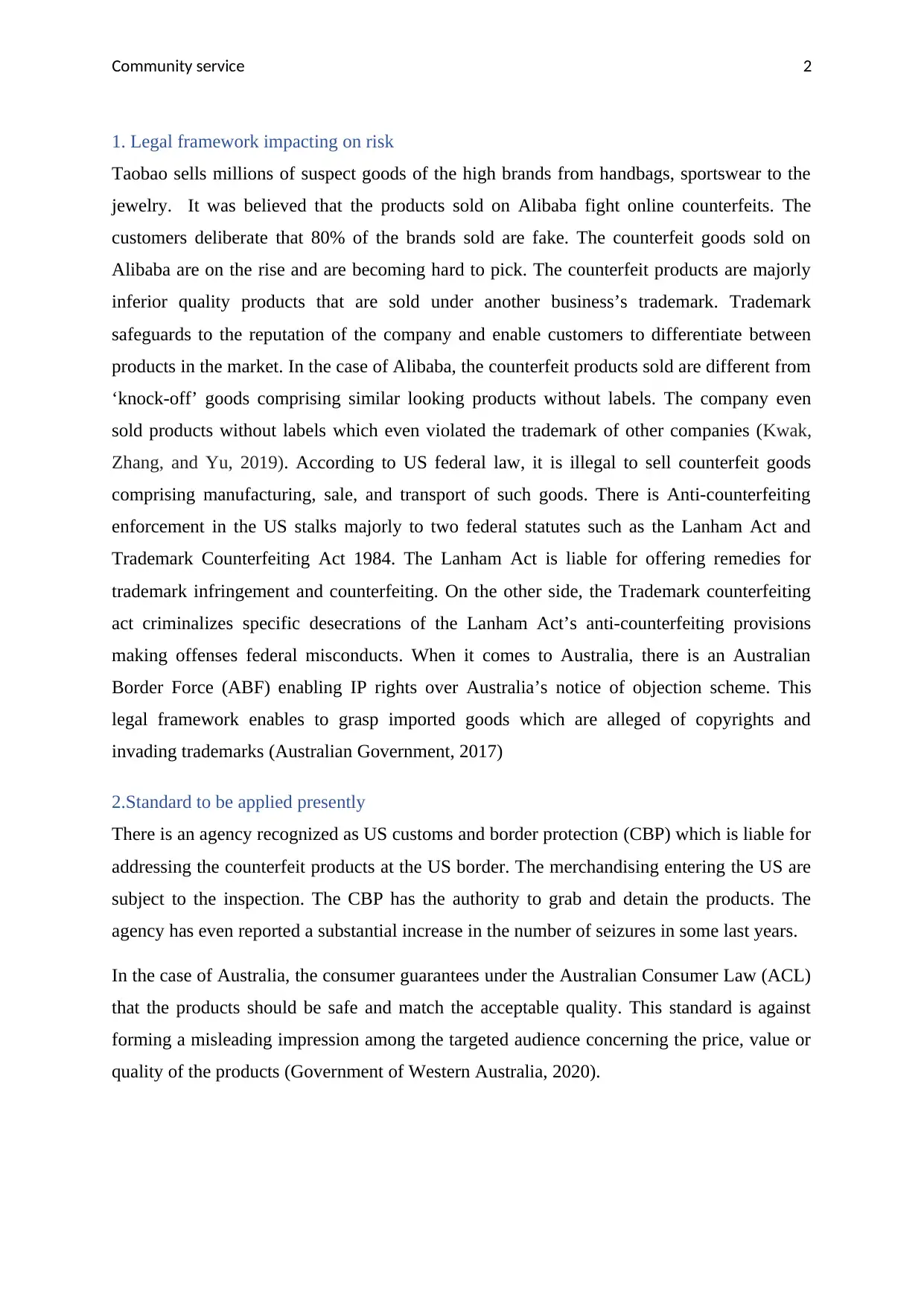
Community service 2
1. Legal framework impacting on risk
Taobao sells millions of suspect goods of the high brands from handbags, sportswear to the
jewelry. It was believed that the products sold on Alibaba fight online counterfeits. The
customers deliberate that 80% of the brands sold are fake. The counterfeit goods sold on
Alibaba are on the rise and are becoming hard to pick. The counterfeit products are majorly
inferior quality products that are sold under another business’s trademark. Trademark
safeguards to the reputation of the company and enable customers to differentiate between
products in the market. In the case of Alibaba, the counterfeit products sold are different from
‘knock-off’ goods comprising similar looking products without labels. The company even
sold products without labels which even violated the trademark of other companies (Kwak,
Zhang, and Yu, 2019). According to US federal law, it is illegal to sell counterfeit goods
comprising manufacturing, sale, and transport of such goods. There is Anti-counterfeiting
enforcement in the US stalks majorly to two federal statutes such as the Lanham Act and
Trademark Counterfeiting Act 1984. The Lanham Act is liable for offering remedies for
trademark infringement and counterfeiting. On the other side, the Trademark counterfeiting
act criminalizes specific desecrations of the Lanham Act’s anti-counterfeiting provisions
making offenses federal misconducts. When it comes to Australia, there is an Australian
Border Force (ABF) enabling IP rights over Australia’s notice of objection scheme. This
legal framework enables to grasp imported goods which are alleged of copyrights and
invading trademarks (Australian Government, 2017)
2.Standard to be applied presently
There is an agency recognized as US customs and border protection (CBP) which is liable for
addressing the counterfeit products at the US border. The merchandising entering the US are
subject to the inspection. The CBP has the authority to grab and detain the products. The
agency has even reported a substantial increase in the number of seizures in some last years.
In the case of Australia, the consumer guarantees under the Australian Consumer Law (ACL)
that the products should be safe and match the acceptable quality. This standard is against
forming a misleading impression among the targeted audience concerning the price, value or
quality of the products (Government of Western Australia, 2020).
1. Legal framework impacting on risk
Taobao sells millions of suspect goods of the high brands from handbags, sportswear to the
jewelry. It was believed that the products sold on Alibaba fight online counterfeits. The
customers deliberate that 80% of the brands sold are fake. The counterfeit goods sold on
Alibaba are on the rise and are becoming hard to pick. The counterfeit products are majorly
inferior quality products that are sold under another business’s trademark. Trademark
safeguards to the reputation of the company and enable customers to differentiate between
products in the market. In the case of Alibaba, the counterfeit products sold are different from
‘knock-off’ goods comprising similar looking products without labels. The company even
sold products without labels which even violated the trademark of other companies (Kwak,
Zhang, and Yu, 2019). According to US federal law, it is illegal to sell counterfeit goods
comprising manufacturing, sale, and transport of such goods. There is Anti-counterfeiting
enforcement in the US stalks majorly to two federal statutes such as the Lanham Act and
Trademark Counterfeiting Act 1984. The Lanham Act is liable for offering remedies for
trademark infringement and counterfeiting. On the other side, the Trademark counterfeiting
act criminalizes specific desecrations of the Lanham Act’s anti-counterfeiting provisions
making offenses federal misconducts. When it comes to Australia, there is an Australian
Border Force (ABF) enabling IP rights over Australia’s notice of objection scheme. This
legal framework enables to grasp imported goods which are alleged of copyrights and
invading trademarks (Australian Government, 2017)
2.Standard to be applied presently
There is an agency recognized as US customs and border protection (CBP) which is liable for
addressing the counterfeit products at the US border. The merchandising entering the US are
subject to the inspection. The CBP has the authority to grab and detain the products. The
agency has even reported a substantial increase in the number of seizures in some last years.
In the case of Australia, the consumer guarantees under the Australian Consumer Law (ACL)
that the products should be safe and match the acceptable quality. This standard is against
forming a misleading impression among the targeted audience concerning the price, value or
quality of the products (Government of Western Australia, 2020).
⊘ This is a preview!⊘
Do you want full access?
Subscribe today to unlock all pages.

Trusted by 1+ million students worldwide
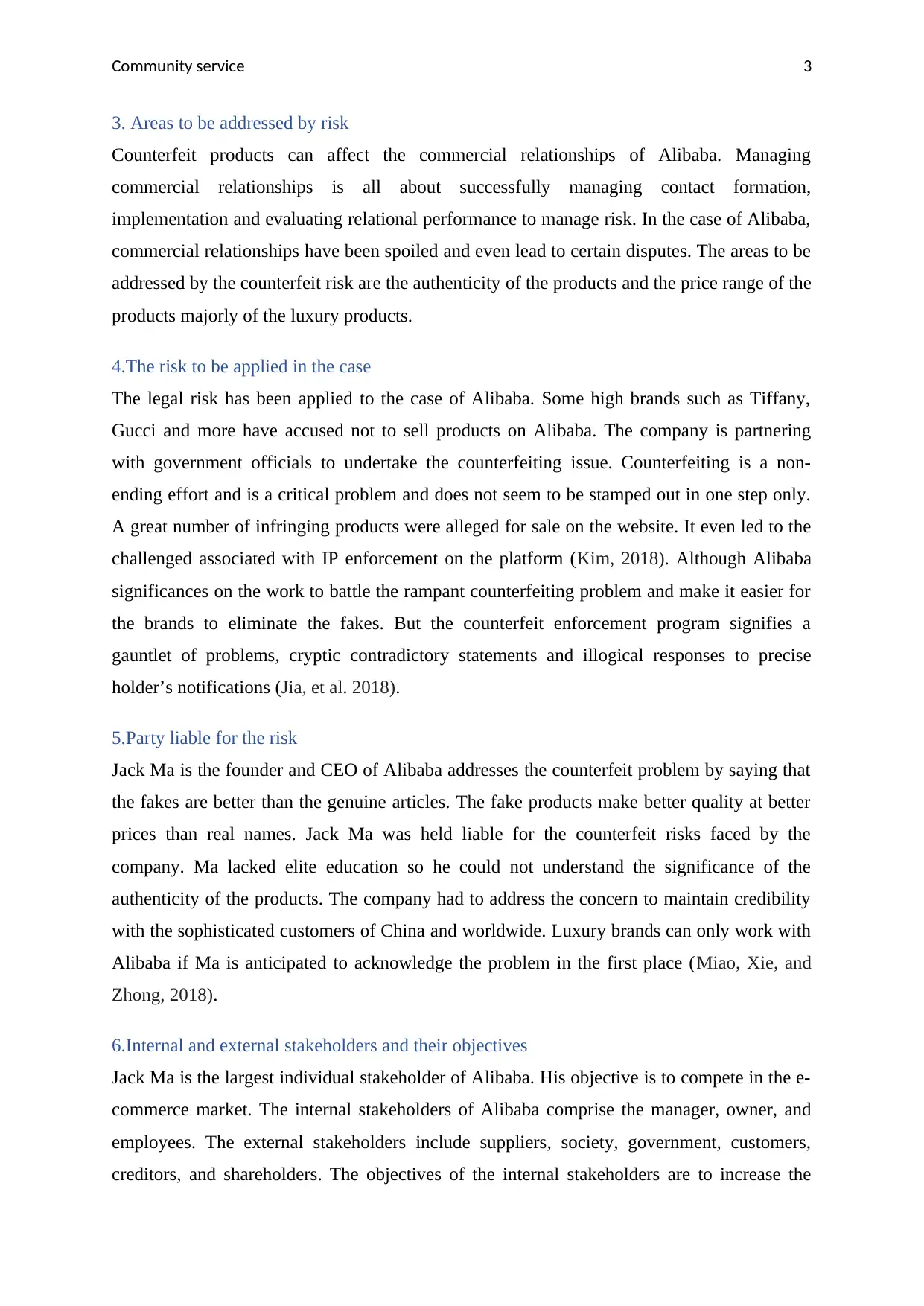
Community service 3
3. Areas to be addressed by risk
Counterfeit products can affect the commercial relationships of Alibaba. Managing
commercial relationships is all about successfully managing contact formation,
implementation and evaluating relational performance to manage risk. In the case of Alibaba,
commercial relationships have been spoiled and even lead to certain disputes. The areas to be
addressed by the counterfeit risk are the authenticity of the products and the price range of the
products majorly of the luxury products.
4.The risk to be applied in the case
The legal risk has been applied to the case of Alibaba. Some high brands such as Tiffany,
Gucci and more have accused not to sell products on Alibaba. The company is partnering
with government officials to undertake the counterfeiting issue. Counterfeiting is a non-
ending effort and is a critical problem and does not seem to be stamped out in one step only.
A great number of infringing products were alleged for sale on the website. It even led to the
challenged associated with IP enforcement on the platform (Kim, 2018). Although Alibaba
significances on the work to battle the rampant counterfeiting problem and make it easier for
the brands to eliminate the fakes. But the counterfeit enforcement program signifies a
gauntlet of problems, cryptic contradictory statements and illogical responses to precise
holder’s notifications (Jia, et al. 2018).
5.Party liable for the risk
Jack Ma is the founder and CEO of Alibaba addresses the counterfeit problem by saying that
the fakes are better than the genuine articles. The fake products make better quality at better
prices than real names. Jack Ma was held liable for the counterfeit risks faced by the
company. Ma lacked elite education so he could not understand the significance of the
authenticity of the products. The company had to address the concern to maintain credibility
with the sophisticated customers of China and worldwide. Luxury brands can only work with
Alibaba if Ma is anticipated to acknowledge the problem in the first place (Miao, Xie, and
Zhong, 2018).
6.Internal and external stakeholders and their objectives
Jack Ma is the largest individual stakeholder of Alibaba. His objective is to compete in the e-
commerce market. The internal stakeholders of Alibaba comprise the manager, owner, and
employees. The external stakeholders include suppliers, society, government, customers,
creditors, and shareholders. The objectives of the internal stakeholders are to increase the
3. Areas to be addressed by risk
Counterfeit products can affect the commercial relationships of Alibaba. Managing
commercial relationships is all about successfully managing contact formation,
implementation and evaluating relational performance to manage risk. In the case of Alibaba,
commercial relationships have been spoiled and even lead to certain disputes. The areas to be
addressed by the counterfeit risk are the authenticity of the products and the price range of the
products majorly of the luxury products.
4.The risk to be applied in the case
The legal risk has been applied to the case of Alibaba. Some high brands such as Tiffany,
Gucci and more have accused not to sell products on Alibaba. The company is partnering
with government officials to undertake the counterfeiting issue. Counterfeiting is a non-
ending effort and is a critical problem and does not seem to be stamped out in one step only.
A great number of infringing products were alleged for sale on the website. It even led to the
challenged associated with IP enforcement on the platform (Kim, 2018). Although Alibaba
significances on the work to battle the rampant counterfeiting problem and make it easier for
the brands to eliminate the fakes. But the counterfeit enforcement program signifies a
gauntlet of problems, cryptic contradictory statements and illogical responses to precise
holder’s notifications (Jia, et al. 2018).
5.Party liable for the risk
Jack Ma is the founder and CEO of Alibaba addresses the counterfeit problem by saying that
the fakes are better than the genuine articles. The fake products make better quality at better
prices than real names. Jack Ma was held liable for the counterfeit risks faced by the
company. Ma lacked elite education so he could not understand the significance of the
authenticity of the products. The company had to address the concern to maintain credibility
with the sophisticated customers of China and worldwide. Luxury brands can only work with
Alibaba if Ma is anticipated to acknowledge the problem in the first place (Miao, Xie, and
Zhong, 2018).
6.Internal and external stakeholders and their objectives
Jack Ma is the largest individual stakeholder of Alibaba. His objective is to compete in the e-
commerce market. The internal stakeholders of Alibaba comprise the manager, owner, and
employees. The external stakeholders include suppliers, society, government, customers,
creditors, and shareholders. The objectives of the internal stakeholders are to increase the
Paraphrase This Document
Need a fresh take? Get an instant paraphrase of this document with our AI Paraphraser
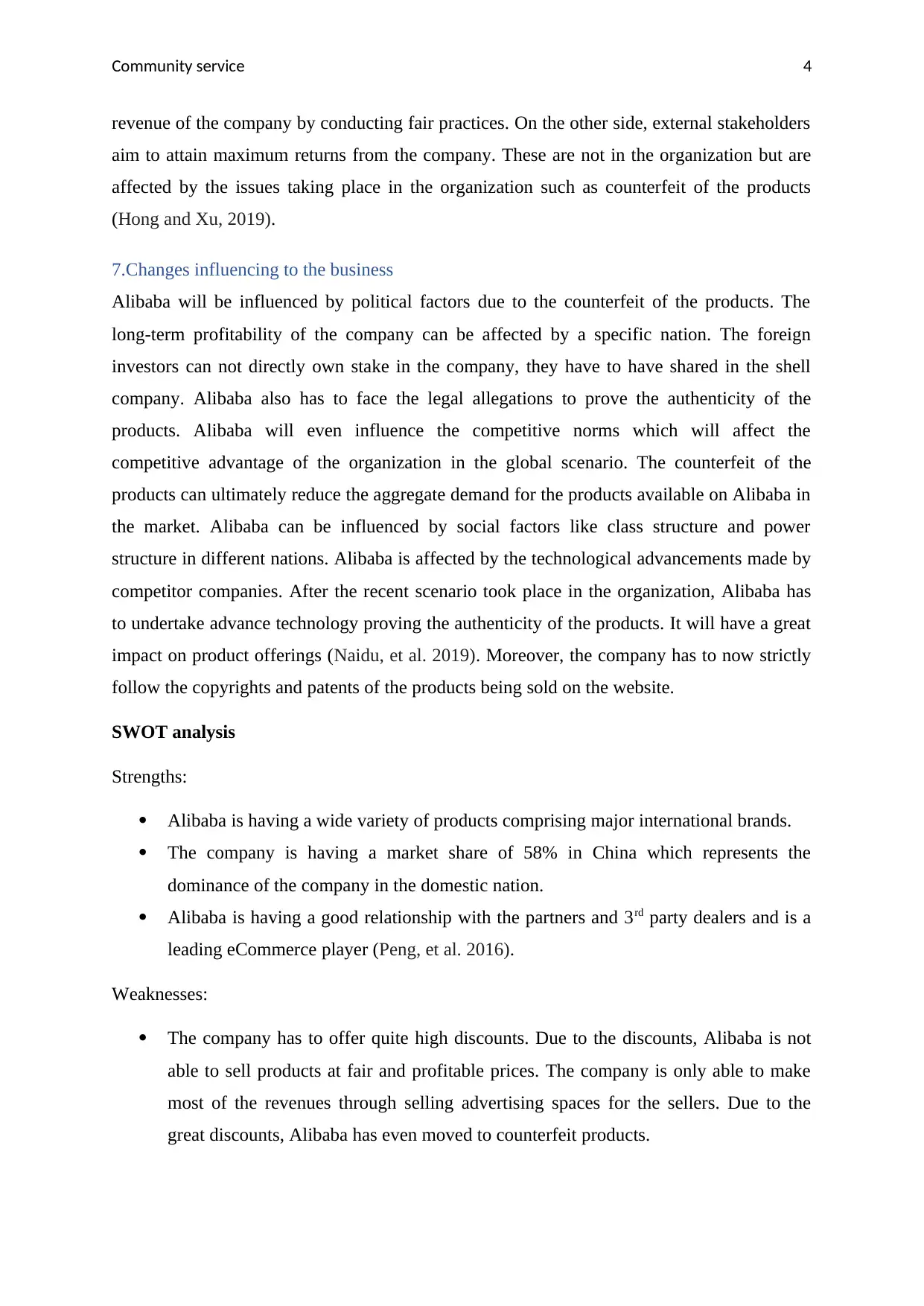
Community service 4
revenue of the company by conducting fair practices. On the other side, external stakeholders
aim to attain maximum returns from the company. These are not in the organization but are
affected by the issues taking place in the organization such as counterfeit of the products
(Hong and Xu, 2019).
7.Changes influencing to the business
Alibaba will be influenced by political factors due to the counterfeit of the products. The
long-term profitability of the company can be affected by a specific nation. The foreign
investors can not directly own stake in the company, they have to have shared in the shell
company. Alibaba also has to face the legal allegations to prove the authenticity of the
products. Alibaba will even influence the competitive norms which will affect the
competitive advantage of the organization in the global scenario. The counterfeit of the
products can ultimately reduce the aggregate demand for the products available on Alibaba in
the market. Alibaba can be influenced by social factors like class structure and power
structure in different nations. Alibaba is affected by the technological advancements made by
competitor companies. After the recent scenario took place in the organization, Alibaba has
to undertake advance technology proving the authenticity of the products. It will have a great
impact on product offerings (Naidu, et al. 2019). Moreover, the company has to now strictly
follow the copyrights and patents of the products being sold on the website.
SWOT analysis
Strengths:
Alibaba is having a wide variety of products comprising major international brands.
The company is having a market share of 58% in China which represents the
dominance of the company in the domestic nation.
Alibaba is having a good relationship with the partners and 3rd party dealers and is a
leading eCommerce player (Peng, et al. 2016).
Weaknesses:
The company has to offer quite high discounts. Due to the discounts, Alibaba is not
able to sell products at fair and profitable prices. The company is only able to make
most of the revenues through selling advertising spaces for the sellers. Due to the
great discounts, Alibaba has even moved to counterfeit products.
revenue of the company by conducting fair practices. On the other side, external stakeholders
aim to attain maximum returns from the company. These are not in the organization but are
affected by the issues taking place in the organization such as counterfeit of the products
(Hong and Xu, 2019).
7.Changes influencing to the business
Alibaba will be influenced by political factors due to the counterfeit of the products. The
long-term profitability of the company can be affected by a specific nation. The foreign
investors can not directly own stake in the company, they have to have shared in the shell
company. Alibaba also has to face the legal allegations to prove the authenticity of the
products. Alibaba will even influence the competitive norms which will affect the
competitive advantage of the organization in the global scenario. The counterfeit of the
products can ultimately reduce the aggregate demand for the products available on Alibaba in
the market. Alibaba can be influenced by social factors like class structure and power
structure in different nations. Alibaba is affected by the technological advancements made by
competitor companies. After the recent scenario took place in the organization, Alibaba has
to undertake advance technology proving the authenticity of the products. It will have a great
impact on product offerings (Naidu, et al. 2019). Moreover, the company has to now strictly
follow the copyrights and patents of the products being sold on the website.
SWOT analysis
Strengths:
Alibaba is having a wide variety of products comprising major international brands.
The company is having a market share of 58% in China which represents the
dominance of the company in the domestic nation.
Alibaba is having a good relationship with the partners and 3rd party dealers and is a
leading eCommerce player (Peng, et al. 2016).
Weaknesses:
The company has to offer quite high discounts. Due to the discounts, Alibaba is not
able to sell products at fair and profitable prices. The company is only able to make
most of the revenues through selling advertising spaces for the sellers. Due to the
great discounts, Alibaba has even moved to counterfeit products.
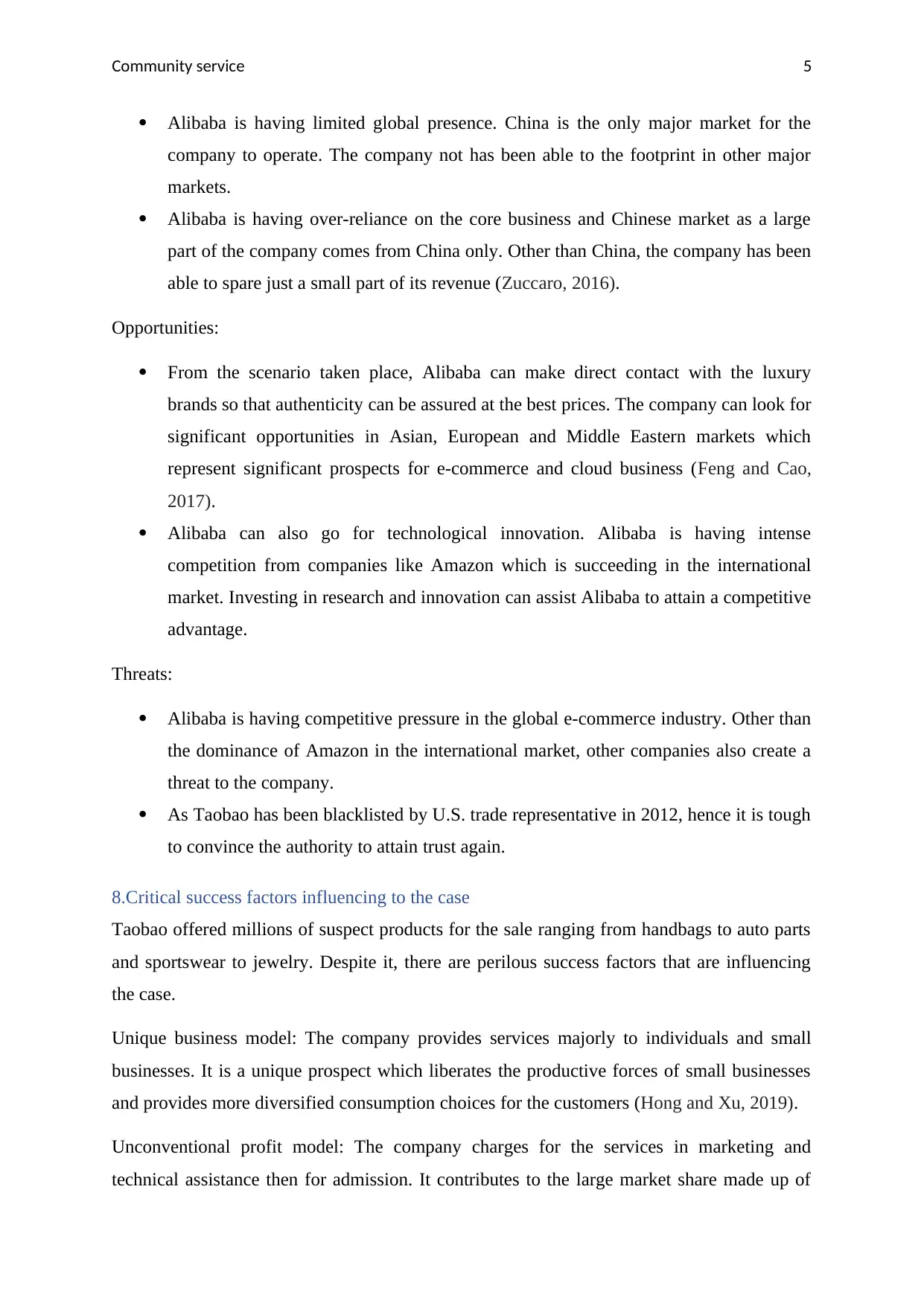
Community service 5
Alibaba is having limited global presence. China is the only major market for the
company to operate. The company not has been able to the footprint in other major
markets.
Alibaba is having over-reliance on the core business and Chinese market as a large
part of the company comes from China only. Other than China, the company has been
able to spare just a small part of its revenue (Zuccaro, 2016).
Opportunities:
From the scenario taken place, Alibaba can make direct contact with the luxury
brands so that authenticity can be assured at the best prices. The company can look for
significant opportunities in Asian, European and Middle Eastern markets which
represent significant prospects for e-commerce and cloud business (Feng and Cao,
2017).
Alibaba can also go for technological innovation. Alibaba is having intense
competition from companies like Amazon which is succeeding in the international
market. Investing in research and innovation can assist Alibaba to attain a competitive
advantage.
Threats:
Alibaba is having competitive pressure in the global e-commerce industry. Other than
the dominance of Amazon in the international market, other companies also create a
threat to the company.
As Taobao has been blacklisted by U.S. trade representative in 2012, hence it is tough
to convince the authority to attain trust again.
8.Critical success factors influencing to the case
Taobao offered millions of suspect products for the sale ranging from handbags to auto parts
and sportswear to jewelry. Despite it, there are perilous success factors that are influencing
the case.
Unique business model: The company provides services majorly to individuals and small
businesses. It is a unique prospect which liberates the productive forces of small businesses
and provides more diversified consumption choices for the customers (Hong and Xu, 2019).
Unconventional profit model: The company charges for the services in marketing and
technical assistance then for admission. It contributes to the large market share made up of
Alibaba is having limited global presence. China is the only major market for the
company to operate. The company not has been able to the footprint in other major
markets.
Alibaba is having over-reliance on the core business and Chinese market as a large
part of the company comes from China only. Other than China, the company has been
able to spare just a small part of its revenue (Zuccaro, 2016).
Opportunities:
From the scenario taken place, Alibaba can make direct contact with the luxury
brands so that authenticity can be assured at the best prices. The company can look for
significant opportunities in Asian, European and Middle Eastern markets which
represent significant prospects for e-commerce and cloud business (Feng and Cao,
2017).
Alibaba can also go for technological innovation. Alibaba is having intense
competition from companies like Amazon which is succeeding in the international
market. Investing in research and innovation can assist Alibaba to attain a competitive
advantage.
Threats:
Alibaba is having competitive pressure in the global e-commerce industry. Other than
the dominance of Amazon in the international market, other companies also create a
threat to the company.
As Taobao has been blacklisted by U.S. trade representative in 2012, hence it is tough
to convince the authority to attain trust again.
8.Critical success factors influencing to the case
Taobao offered millions of suspect products for the sale ranging from handbags to auto parts
and sportswear to jewelry. Despite it, there are perilous success factors that are influencing
the case.
Unique business model: The company provides services majorly to individuals and small
businesses. It is a unique prospect which liberates the productive forces of small businesses
and provides more diversified consumption choices for the customers (Hong and Xu, 2019).
Unconventional profit model: The company charges for the services in marketing and
technical assistance then for admission. It contributes to the large market share made up of
⊘ This is a preview!⊘
Do you want full access?
Subscribe today to unlock all pages.

Trusted by 1+ million students worldwide
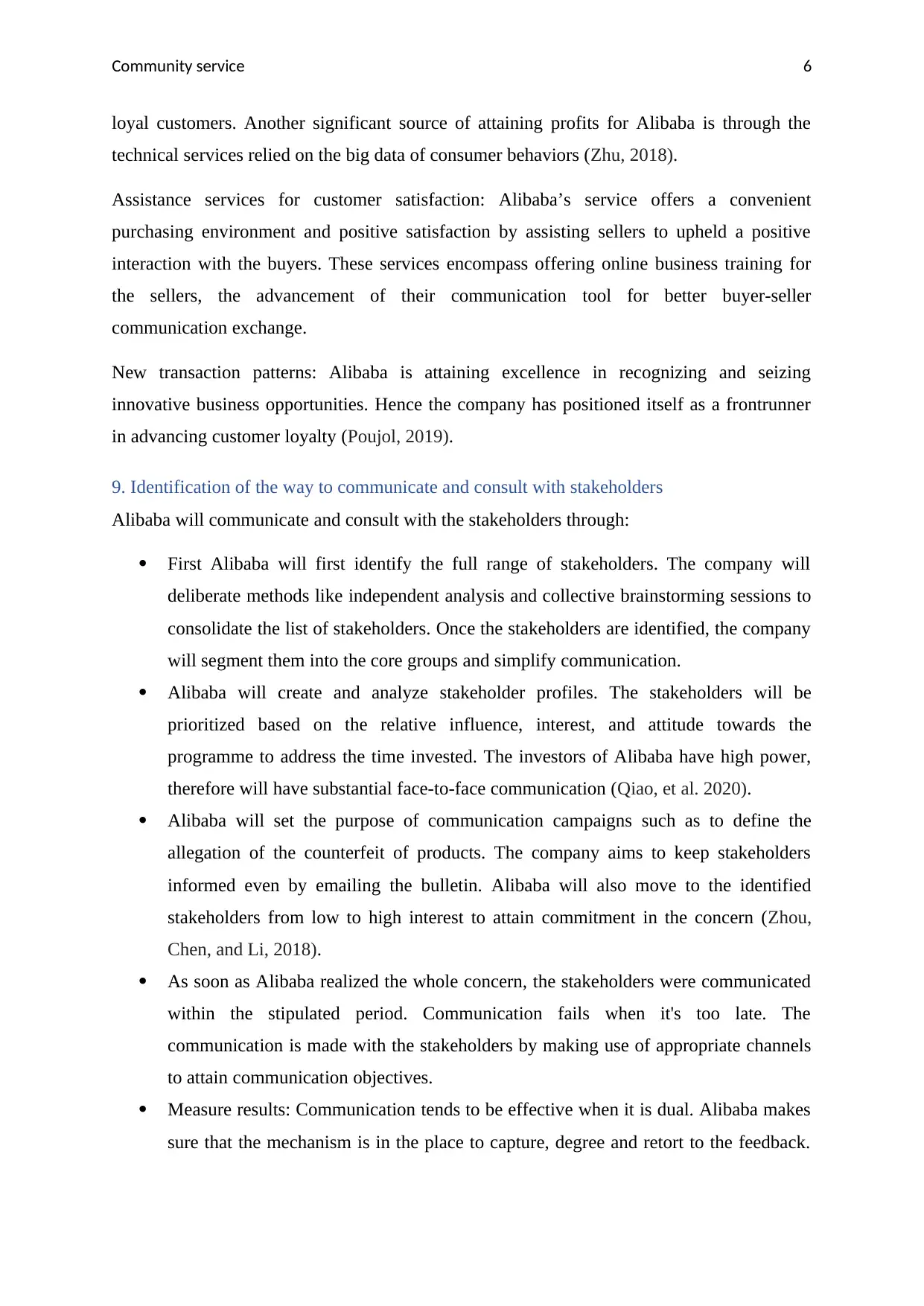
Community service 6
loyal customers. Another significant source of attaining profits for Alibaba is through the
technical services relied on the big data of consumer behaviors (Zhu, 2018).
Assistance services for customer satisfaction: Alibaba’s service offers a convenient
purchasing environment and positive satisfaction by assisting sellers to upheld a positive
interaction with the buyers. These services encompass offering online business training for
the sellers, the advancement of their communication tool for better buyer-seller
communication exchange.
New transaction patterns: Alibaba is attaining excellence in recognizing and seizing
innovative business opportunities. Hence the company has positioned itself as a frontrunner
in advancing customer loyalty (Poujol, 2019).
9. Identification of the way to communicate and consult with stakeholders
Alibaba will communicate and consult with the stakeholders through:
First Alibaba will first identify the full range of stakeholders. The company will
deliberate methods like independent analysis and collective brainstorming sessions to
consolidate the list of stakeholders. Once the stakeholders are identified, the company
will segment them into the core groups and simplify communication.
Alibaba will create and analyze stakeholder profiles. The stakeholders will be
prioritized based on the relative influence, interest, and attitude towards the
programme to address the time invested. The investors of Alibaba have high power,
therefore will have substantial face-to-face communication (Qiao, et al. 2020).
Alibaba will set the purpose of communication campaigns such as to define the
allegation of the counterfeit of products. The company aims to keep stakeholders
informed even by emailing the bulletin. Alibaba will also move to the identified
stakeholders from low to high interest to attain commitment in the concern (Zhou,
Chen, and Li, 2018).
As soon as Alibaba realized the whole concern, the stakeholders were communicated
within the stipulated period. Communication fails when it's too late. The
communication is made with the stakeholders by making use of appropriate channels
to attain communication objectives.
Measure results: Communication tends to be effective when it is dual. Alibaba makes
sure that the mechanism is in the place to capture, degree and retort to the feedback.
loyal customers. Another significant source of attaining profits for Alibaba is through the
technical services relied on the big data of consumer behaviors (Zhu, 2018).
Assistance services for customer satisfaction: Alibaba’s service offers a convenient
purchasing environment and positive satisfaction by assisting sellers to upheld a positive
interaction with the buyers. These services encompass offering online business training for
the sellers, the advancement of their communication tool for better buyer-seller
communication exchange.
New transaction patterns: Alibaba is attaining excellence in recognizing and seizing
innovative business opportunities. Hence the company has positioned itself as a frontrunner
in advancing customer loyalty (Poujol, 2019).
9. Identification of the way to communicate and consult with stakeholders
Alibaba will communicate and consult with the stakeholders through:
First Alibaba will first identify the full range of stakeholders. The company will
deliberate methods like independent analysis and collective brainstorming sessions to
consolidate the list of stakeholders. Once the stakeholders are identified, the company
will segment them into the core groups and simplify communication.
Alibaba will create and analyze stakeholder profiles. The stakeholders will be
prioritized based on the relative influence, interest, and attitude towards the
programme to address the time invested. The investors of Alibaba have high power,
therefore will have substantial face-to-face communication (Qiao, et al. 2020).
Alibaba will set the purpose of communication campaigns such as to define the
allegation of the counterfeit of products. The company aims to keep stakeholders
informed even by emailing the bulletin. Alibaba will also move to the identified
stakeholders from low to high interest to attain commitment in the concern (Zhou,
Chen, and Li, 2018).
As soon as Alibaba realized the whole concern, the stakeholders were communicated
within the stipulated period. Communication fails when it's too late. The
communication is made with the stakeholders by making use of appropriate channels
to attain communication objectives.
Measure results: Communication tends to be effective when it is dual. Alibaba makes
sure that the mechanism is in the place to capture, degree and retort to the feedback.
Paraphrase This Document
Need a fresh take? Get an instant paraphrase of this document with our AI Paraphraser
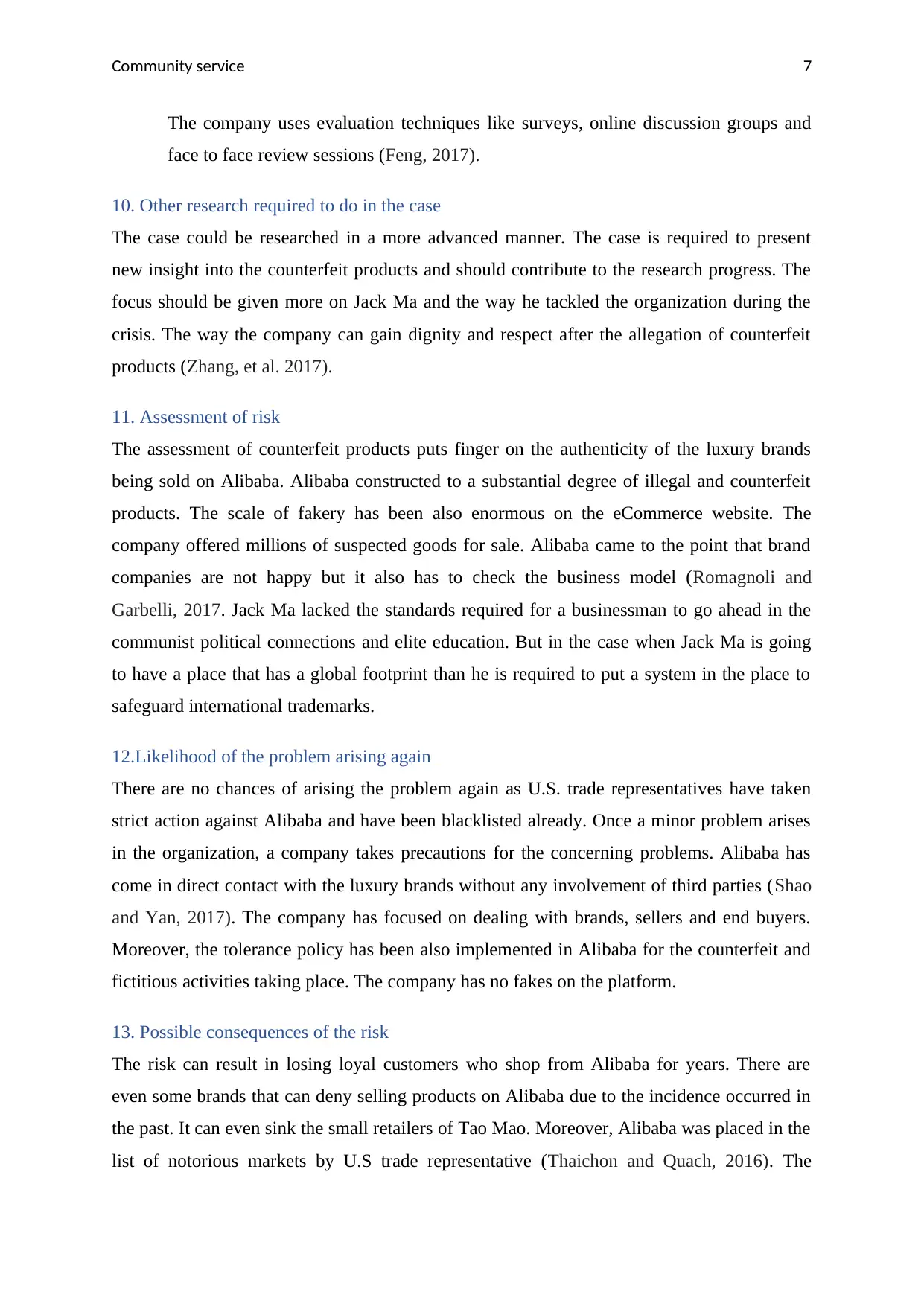
Community service 7
The company uses evaluation techniques like surveys, online discussion groups and
face to face review sessions (Feng, 2017).
10. Other research required to do in the case
The case could be researched in a more advanced manner. The case is required to present
new insight into the counterfeit products and should contribute to the research progress. The
focus should be given more on Jack Ma and the way he tackled the organization during the
crisis. The way the company can gain dignity and respect after the allegation of counterfeit
products (Zhang, et al. 2017).
11. Assessment of risk
The assessment of counterfeit products puts finger on the authenticity of the luxury brands
being sold on Alibaba. Alibaba constructed to a substantial degree of illegal and counterfeit
products. The scale of fakery has been also enormous on the eCommerce website. The
company offered millions of suspected goods for sale. Alibaba came to the point that brand
companies are not happy but it also has to check the business model (Romagnoli and
Garbelli, 2017. Jack Ma lacked the standards required for a businessman to go ahead in the
communist political connections and elite education. But in the case when Jack Ma is going
to have a place that has a global footprint than he is required to put a system in the place to
safeguard international trademarks.
12.Likelihood of the problem arising again
There are no chances of arising the problem again as U.S. trade representatives have taken
strict action against Alibaba and have been blacklisted already. Once a minor problem arises
in the organization, a company takes precautions for the concerning problems. Alibaba has
come in direct contact with the luxury brands without any involvement of third parties (Shao
and Yan, 2017). The company has focused on dealing with brands, sellers and end buyers.
Moreover, the tolerance policy has been also implemented in Alibaba for the counterfeit and
fictitious activities taking place. The company has no fakes on the platform.
13. Possible consequences of the risk
The risk can result in losing loyal customers who shop from Alibaba for years. There are
even some brands that can deny selling products on Alibaba due to the incidence occurred in
the past. It can even sink the small retailers of Tao Mao. Moreover, Alibaba was placed in the
list of notorious markets by U.S trade representative (Thaichon and Quach, 2016). The
The company uses evaluation techniques like surveys, online discussion groups and
face to face review sessions (Feng, 2017).
10. Other research required to do in the case
The case could be researched in a more advanced manner. The case is required to present
new insight into the counterfeit products and should contribute to the research progress. The
focus should be given more on Jack Ma and the way he tackled the organization during the
crisis. The way the company can gain dignity and respect after the allegation of counterfeit
products (Zhang, et al. 2017).
11. Assessment of risk
The assessment of counterfeit products puts finger on the authenticity of the luxury brands
being sold on Alibaba. Alibaba constructed to a substantial degree of illegal and counterfeit
products. The scale of fakery has been also enormous on the eCommerce website. The
company offered millions of suspected goods for sale. Alibaba came to the point that brand
companies are not happy but it also has to check the business model (Romagnoli and
Garbelli, 2017. Jack Ma lacked the standards required for a businessman to go ahead in the
communist political connections and elite education. But in the case when Jack Ma is going
to have a place that has a global footprint than he is required to put a system in the place to
safeguard international trademarks.
12.Likelihood of the problem arising again
There are no chances of arising the problem again as U.S. trade representatives have taken
strict action against Alibaba and have been blacklisted already. Once a minor problem arises
in the organization, a company takes precautions for the concerning problems. Alibaba has
come in direct contact with the luxury brands without any involvement of third parties (Shao
and Yan, 2017). The company has focused on dealing with brands, sellers and end buyers.
Moreover, the tolerance policy has been also implemented in Alibaba for the counterfeit and
fictitious activities taking place. The company has no fakes on the platform.
13. Possible consequences of the risk
The risk can result in losing loyal customers who shop from Alibaba for years. There are
even some brands that can deny selling products on Alibaba due to the incidence occurred in
the past. It can even sink the small retailers of Tao Mao. Moreover, Alibaba was placed in the
list of notorious markets by U.S trade representative (Thaichon and Quach, 2016). The

Community service 8
company even faced a ‘credibility crisis’. Moreover, the company can face questions for the
low price, product quality, and product description. Counterfeit products can be a major thorn
in the organization’s side. The company will be needed to tackle the problem for some time.
14. Evaluation and prioritize of the treatment for the risks
The counterfeit products affect the efficacy of the genuine products. Counterfeit products can
be evaluated by the way customers utilize the products for the intended purpose. The
counterfeiting engenders to the moral disgust and degrades the efficacy of the products which
are perceived to be fake. Once the customers came to know that the products acquired by
them are fake, they can seek for the refunds to the company (Ebel, 2016).
Alibaba can do more for tackling the risk by improving the IP protection program for some
time. It claims to manage all takedown requests within twenty-four hours. The company can
sue vendors selling fake products on the website. Alibaba can even treat risks by toughening
laws and penalties against the counterfeiters along with fostering relationships with the
brands. Big data anti-counterfeiting alliance can be made with the brands to enable action
infringers (Zhang and Wang, 2018).
15. Risk priority to be considered
Alibaba needs to enable tough laws and penalties against the parties selling fake products on
the website. Taobao selling products should register their trademark in China so that their
authenticity can be established. The company can take action against the counterfeiters.
Alibaba even needs to invest in anti-counterfeit technology such as QR and RFID schemes to
enable blockchain technology to avert fraud and counterfeiting. The QR codes and RFID tags
are used to track products as they move from factories to the customers. The tags are digital
product ID which is scanned every time the product changes hands. This way customers can
trace the origin with history. The luxury brands should be tagged so that the database can be
feed with sharing all the actors in the supply chain (Zhang and Ravishankar, 2019).
16. Opportunities in the case along with the usage
Alibaba can attain opportunities after the incidence occurred. The company can attain the
opportunity to work closely with the brands to tackle counterfeits. Alibaba improved its IP
protection program to take down the requests within 24 hours. The company got the
opportunity to take down infringing lists which resulted in a 25% decline in taking down.
company even faced a ‘credibility crisis’. Moreover, the company can face questions for the
low price, product quality, and product description. Counterfeit products can be a major thorn
in the organization’s side. The company will be needed to tackle the problem for some time.
14. Evaluation and prioritize of the treatment for the risks
The counterfeit products affect the efficacy of the genuine products. Counterfeit products can
be evaluated by the way customers utilize the products for the intended purpose. The
counterfeiting engenders to the moral disgust and degrades the efficacy of the products which
are perceived to be fake. Once the customers came to know that the products acquired by
them are fake, they can seek for the refunds to the company (Ebel, 2016).
Alibaba can do more for tackling the risk by improving the IP protection program for some
time. It claims to manage all takedown requests within twenty-four hours. The company can
sue vendors selling fake products on the website. Alibaba can even treat risks by toughening
laws and penalties against the counterfeiters along with fostering relationships with the
brands. Big data anti-counterfeiting alliance can be made with the brands to enable action
infringers (Zhang and Wang, 2018).
15. Risk priority to be considered
Alibaba needs to enable tough laws and penalties against the parties selling fake products on
the website. Taobao selling products should register their trademark in China so that their
authenticity can be established. The company can take action against the counterfeiters.
Alibaba even needs to invest in anti-counterfeit technology such as QR and RFID schemes to
enable blockchain technology to avert fraud and counterfeiting. The QR codes and RFID tags
are used to track products as they move from factories to the customers. The tags are digital
product ID which is scanned every time the product changes hands. This way customers can
trace the origin with history. The luxury brands should be tagged so that the database can be
feed with sharing all the actors in the supply chain (Zhang and Ravishankar, 2019).
16. Opportunities in the case along with the usage
Alibaba can attain opportunities after the incidence occurred. The company can attain the
opportunity to work closely with the brands to tackle counterfeits. Alibaba improved its IP
protection program to take down the requests within 24 hours. The company got the
opportunity to take down infringing lists which resulted in a 25% decline in taking down.
⊘ This is a preview!⊘
Do you want full access?
Subscribe today to unlock all pages.

Trusted by 1+ million students worldwide
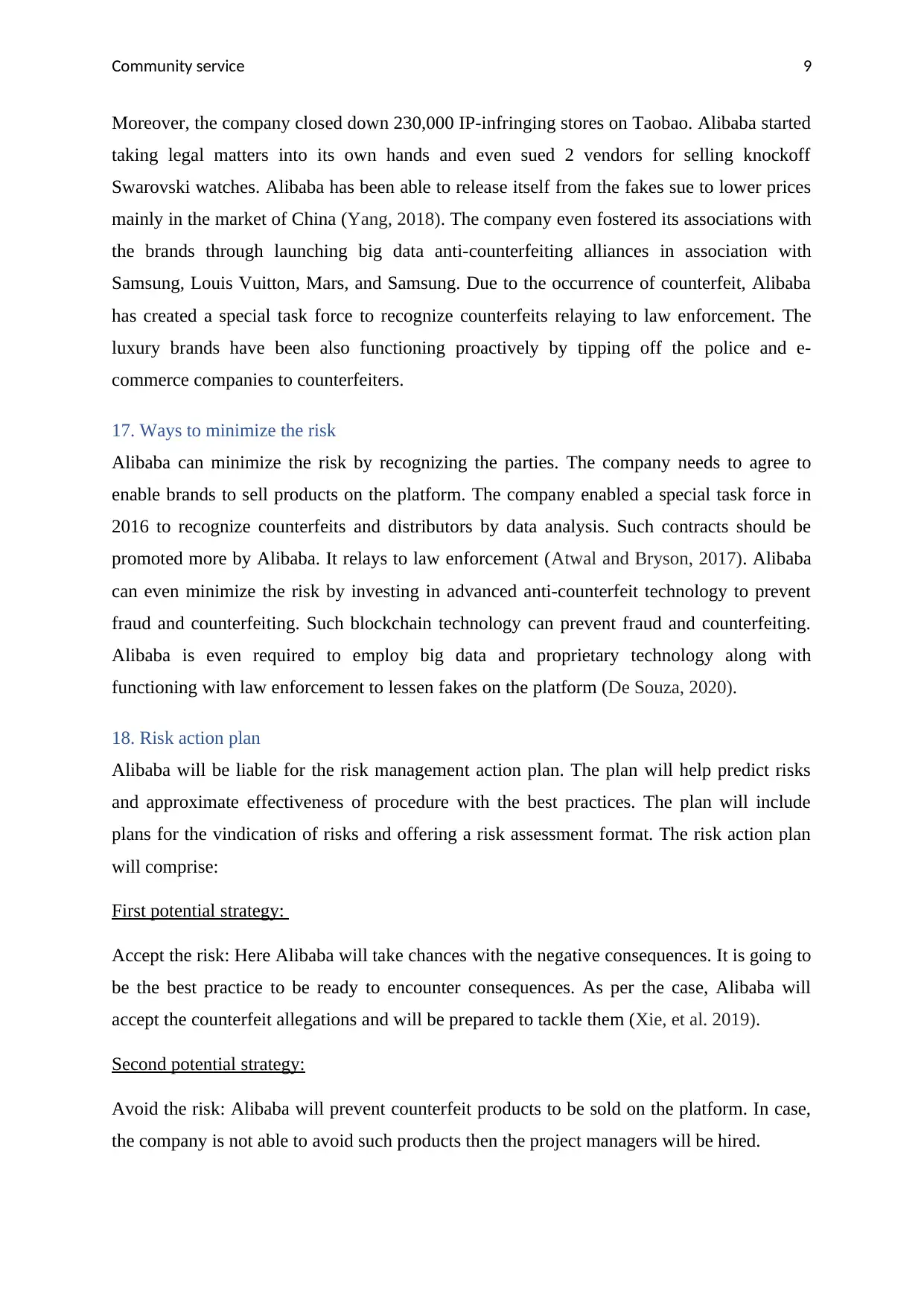
Community service 9
Moreover, the company closed down 230,000 IP-infringing stores on Taobao. Alibaba started
taking legal matters into its own hands and even sued 2 vendors for selling knockoff
Swarovski watches. Alibaba has been able to release itself from the fakes sue to lower prices
mainly in the market of China (Yang, 2018). The company even fostered its associations with
the brands through launching big data anti-counterfeiting alliances in association with
Samsung, Louis Vuitton, Mars, and Samsung. Due to the occurrence of counterfeit, Alibaba
has created a special task force to recognize counterfeits relaying to law enforcement. The
luxury brands have been also functioning proactively by tipping off the police and e-
commerce companies to counterfeiters.
17. Ways to minimize the risk
Alibaba can minimize the risk by recognizing the parties. The company needs to agree to
enable brands to sell products on the platform. The company enabled a special task force in
2016 to recognize counterfeits and distributors by data analysis. Such contracts should be
promoted more by Alibaba. It relays to law enforcement (Atwal and Bryson, 2017). Alibaba
can even minimize the risk by investing in advanced anti-counterfeit technology to prevent
fraud and counterfeiting. Such blockchain technology can prevent fraud and counterfeiting.
Alibaba is even required to employ big data and proprietary technology along with
functioning with law enforcement to lessen fakes on the platform (De Souza, 2020).
18. Risk action plan
Alibaba will be liable for the risk management action plan. The plan will help predict risks
and approximate effectiveness of procedure with the best practices. The plan will include
plans for the vindication of risks and offering a risk assessment format. The risk action plan
will comprise:
First potential strategy:
Accept the risk: Here Alibaba will take chances with the negative consequences. It is going to
be the best practice to be ready to encounter consequences. As per the case, Alibaba will
accept the counterfeit allegations and will be prepared to tackle them (Xie, et al. 2019).
Second potential strategy:
Avoid the risk: Alibaba will prevent counterfeit products to be sold on the platform. In case,
the company is not able to avoid such products then the project managers will be hired.
Moreover, the company closed down 230,000 IP-infringing stores on Taobao. Alibaba started
taking legal matters into its own hands and even sued 2 vendors for selling knockoff
Swarovski watches. Alibaba has been able to release itself from the fakes sue to lower prices
mainly in the market of China (Yang, 2018). The company even fostered its associations with
the brands through launching big data anti-counterfeiting alliances in association with
Samsung, Louis Vuitton, Mars, and Samsung. Due to the occurrence of counterfeit, Alibaba
has created a special task force to recognize counterfeits relaying to law enforcement. The
luxury brands have been also functioning proactively by tipping off the police and e-
commerce companies to counterfeiters.
17. Ways to minimize the risk
Alibaba can minimize the risk by recognizing the parties. The company needs to agree to
enable brands to sell products on the platform. The company enabled a special task force in
2016 to recognize counterfeits and distributors by data analysis. Such contracts should be
promoted more by Alibaba. It relays to law enforcement (Atwal and Bryson, 2017). Alibaba
can even minimize the risk by investing in advanced anti-counterfeit technology to prevent
fraud and counterfeiting. Such blockchain technology can prevent fraud and counterfeiting.
Alibaba is even required to employ big data and proprietary technology along with
functioning with law enforcement to lessen fakes on the platform (De Souza, 2020).
18. Risk action plan
Alibaba will be liable for the risk management action plan. The plan will help predict risks
and approximate effectiveness of procedure with the best practices. The plan will include
plans for the vindication of risks and offering a risk assessment format. The risk action plan
will comprise:
First potential strategy:
Accept the risk: Here Alibaba will take chances with the negative consequences. It is going to
be the best practice to be ready to encounter consequences. As per the case, Alibaba will
accept the counterfeit allegations and will be prepared to tackle them (Xie, et al. 2019).
Second potential strategy:
Avoid the risk: Alibaba will prevent counterfeit products to be sold on the platform. In case,
the company is not able to avoid such products then the project managers will be hired.
Paraphrase This Document
Need a fresh take? Get an instant paraphrase of this document with our AI Paraphraser
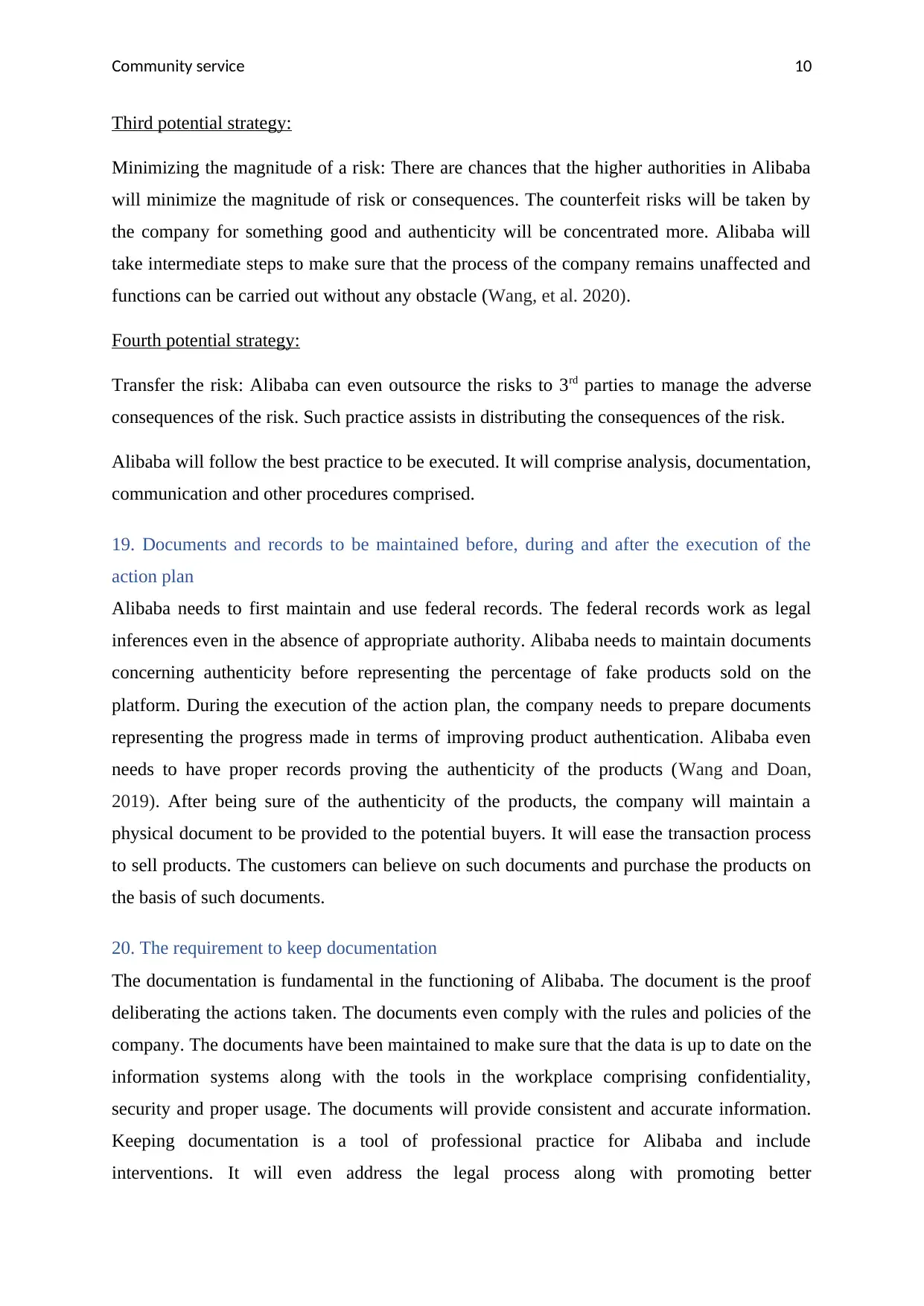
Community service 10
Third potential strategy:
Minimizing the magnitude of a risk: There are chances that the higher authorities in Alibaba
will minimize the magnitude of risk or consequences. The counterfeit risks will be taken by
the company for something good and authenticity will be concentrated more. Alibaba will
take intermediate steps to make sure that the process of the company remains unaffected and
functions can be carried out without any obstacle (Wang, et al. 2020).
Fourth potential strategy:
Transfer the risk: Alibaba can even outsource the risks to 3rd parties to manage the adverse
consequences of the risk. Such practice assists in distributing the consequences of the risk.
Alibaba will follow the best practice to be executed. It will comprise analysis, documentation,
communication and other procedures comprised.
19. Documents and records to be maintained before, during and after the execution of the
action plan
Alibaba needs to first maintain and use federal records. The federal records work as legal
inferences even in the absence of appropriate authority. Alibaba needs to maintain documents
concerning authenticity before representing the percentage of fake products sold on the
platform. During the execution of the action plan, the company needs to prepare documents
representing the progress made in terms of improving product authentication. Alibaba even
needs to have proper records proving the authenticity of the products (Wang and Doan,
2019). After being sure of the authenticity of the products, the company will maintain a
physical document to be provided to the potential buyers. It will ease the transaction process
to sell products. The customers can believe on such documents and purchase the products on
the basis of such documents.
20. The requirement to keep documentation
The documentation is fundamental in the functioning of Alibaba. The document is the proof
deliberating the actions taken. The documents even comply with the rules and policies of the
company. The documents have been maintained to make sure that the data is up to date on the
information systems along with the tools in the workplace comprising confidentiality,
security and proper usage. The documents will provide consistent and accurate information.
Keeping documentation is a tool of professional practice for Alibaba and include
interventions. It will even address the legal process along with promoting better
Third potential strategy:
Minimizing the magnitude of a risk: There are chances that the higher authorities in Alibaba
will minimize the magnitude of risk or consequences. The counterfeit risks will be taken by
the company for something good and authenticity will be concentrated more. Alibaba will
take intermediate steps to make sure that the process of the company remains unaffected and
functions can be carried out without any obstacle (Wang, et al. 2020).
Fourth potential strategy:
Transfer the risk: Alibaba can even outsource the risks to 3rd parties to manage the adverse
consequences of the risk. Such practice assists in distributing the consequences of the risk.
Alibaba will follow the best practice to be executed. It will comprise analysis, documentation,
communication and other procedures comprised.
19. Documents and records to be maintained before, during and after the execution of the
action plan
Alibaba needs to first maintain and use federal records. The federal records work as legal
inferences even in the absence of appropriate authority. Alibaba needs to maintain documents
concerning authenticity before representing the percentage of fake products sold on the
platform. During the execution of the action plan, the company needs to prepare documents
representing the progress made in terms of improving product authentication. Alibaba even
needs to have proper records proving the authenticity of the products (Wang and Doan,
2019). After being sure of the authenticity of the products, the company will maintain a
physical document to be provided to the potential buyers. It will ease the transaction process
to sell products. The customers can believe on such documents and purchase the products on
the basis of such documents.
20. The requirement to keep documentation
The documentation is fundamental in the functioning of Alibaba. The document is the proof
deliberating the actions taken. The documents even comply with the rules and policies of the
company. The documents have been maintained to make sure that the data is up to date on the
information systems along with the tools in the workplace comprising confidentiality,
security and proper usage. The documents will provide consistent and accurate information.
Keeping documentation is a tool of professional practice for Alibaba and include
interventions. It will even address the legal process along with promoting better
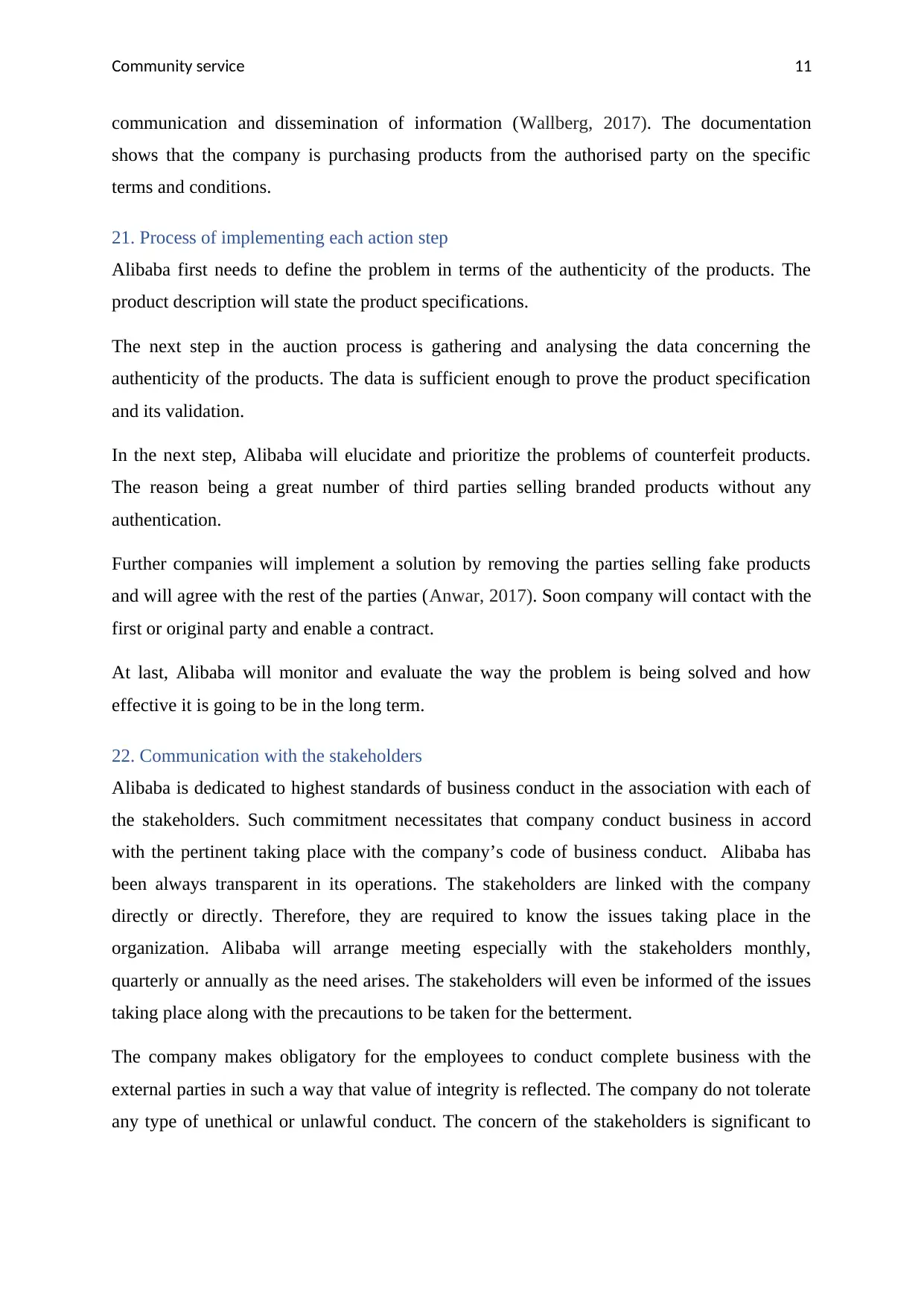
Community service 11
communication and dissemination of information (Wallberg, 2017). The documentation
shows that the company is purchasing products from the authorised party on the specific
terms and conditions.
21. Process of implementing each action step
Alibaba first needs to define the problem in terms of the authenticity of the products. The
product description will state the product specifications.
The next step in the auction process is gathering and analysing the data concerning the
authenticity of the products. The data is sufficient enough to prove the product specification
and its validation.
In the next step, Alibaba will elucidate and prioritize the problems of counterfeit products.
The reason being a great number of third parties selling branded products without any
authentication.
Further companies will implement a solution by removing the parties selling fake products
and will agree with the rest of the parties (Anwar, 2017). Soon company will contact with the
first or original party and enable a contract.
At last, Alibaba will monitor and evaluate the way the problem is being solved and how
effective it is going to be in the long term.
22. Communication with the stakeholders
Alibaba is dedicated to highest standards of business conduct in the association with each of
the stakeholders. Such commitment necessitates that company conduct business in accord
with the pertinent taking place with the company’s code of business conduct. Alibaba has
been always transparent in its operations. The stakeholders are linked with the company
directly or directly. Therefore, they are required to know the issues taking place in the
organization. Alibaba will arrange meeting especially with the stakeholders monthly,
quarterly or annually as the need arises. The stakeholders will even be informed of the issues
taking place along with the precautions to be taken for the betterment.
The company makes obligatory for the employees to conduct complete business with the
external parties in such a way that value of integrity is reflected. The company do not tolerate
any type of unethical or unlawful conduct. The concern of the stakeholders is significant to
communication and dissemination of information (Wallberg, 2017). The documentation
shows that the company is purchasing products from the authorised party on the specific
terms and conditions.
21. Process of implementing each action step
Alibaba first needs to define the problem in terms of the authenticity of the products. The
product description will state the product specifications.
The next step in the auction process is gathering and analysing the data concerning the
authenticity of the products. The data is sufficient enough to prove the product specification
and its validation.
In the next step, Alibaba will elucidate and prioritize the problems of counterfeit products.
The reason being a great number of third parties selling branded products without any
authentication.
Further companies will implement a solution by removing the parties selling fake products
and will agree with the rest of the parties (Anwar, 2017). Soon company will contact with the
first or original party and enable a contract.
At last, Alibaba will monitor and evaluate the way the problem is being solved and how
effective it is going to be in the long term.
22. Communication with the stakeholders
Alibaba is dedicated to highest standards of business conduct in the association with each of
the stakeholders. Such commitment necessitates that company conduct business in accord
with the pertinent taking place with the company’s code of business conduct. Alibaba has
been always transparent in its operations. The stakeholders are linked with the company
directly or directly. Therefore, they are required to know the issues taking place in the
organization. Alibaba will arrange meeting especially with the stakeholders monthly,
quarterly or annually as the need arises. The stakeholders will even be informed of the issues
taking place along with the precautions to be taken for the betterment.
The company makes obligatory for the employees to conduct complete business with the
external parties in such a way that value of integrity is reflected. The company do not tolerate
any type of unethical or unlawful conduct. The concern of the stakeholders is significant to
⊘ This is a preview!⊘
Do you want full access?
Subscribe today to unlock all pages.

Trusted by 1+ million students worldwide
1 out of 17
Your All-in-One AI-Powered Toolkit for Academic Success.
+13062052269
info@desklib.com
Available 24*7 on WhatsApp / Email
![[object Object]](/_next/static/media/star-bottom.7253800d.svg)
Unlock your academic potential
Copyright © 2020–2025 A2Z Services. All Rights Reserved. Developed and managed by ZUCOL.

